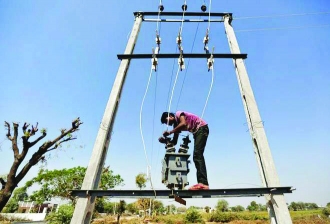The government has started supplying electricity to every village in the country, Prime Minister Narendra Modi announced, a big achievement that now shifts country’s attention towards improving the quality of electricity supply to connect every household to the grid.
Leisang in the hills of Manipur became the 597,464th and the last census village in India to get connected to the electricity grid of the country. This is a remarkable achievement and although work had been going on over the last two decades at a constant pace, it must be said that the Narendra Modi Government had the toughest challenge to connect some of India’s remotest and furthest habitations. This achievement should not be mocked. While some are making a hullabaloo over a supposed image by the US Space agency NASA, the fact is that anybody, who travelled on a night flight over India back in the early-2000’s, could easily tell the difference that the past two decades have made. Far from flying over the heart of darkness, if one caught a flight between Chennai and Delhi, today you can look down from a window seat and see several patches of light where earlier there were none. It has been pointed out, repeatedly one must add, by those pathologically opposed to Prime Minister Narendra Modi that this achievement does not mean that every household has electricity. Which is something the Government realises. Last October, it emerged that almost 36.8 million rural homes did not have access to any form of electricity in India. Since then, according to Government data, only 13 per cent of those homes have been electrified in the last few months. But 30 million homes remain to be electrified and that is not all. Across the country, several million homes, even in urban areas, do not have access to guaranteed 24×7 power. So much so that whole industries have popped up in India, trying to cover the infrastructure gap — inverters and generators.
This challenge is being tackled by the Government and Narendra Modi promised last October that he intends to have electricity in 40 million homes unconnected to the grid by March 2019 under the Saubhagya scheme, which is as ambitious as the very successful ‘Pradhan Mantri Ujjwala Yojana’ and ‘UJALA’ schemes that provided cooking gas and LED lights across the country. However, in meeting the challenge while sticking to our emissions commitments made at global forums will require juggling the needs to lifting millions of Indians out of extreme poverty along with the needs of the planet. While India has taken massive steps towards renewable energy, much of the additional energy demanded in bringing millions of new households into the grid will be through thermal energy generated by coal which will belch billions of tons of carbon dioxide into the atmosphere. This will lead India down a tightrope because given vast swathes of low-lying areas as well as suffering extreme weather phenomena, India will be heavily affected by global warming. We do need to do our utmost to ensure that every single Indian has access to electricity as the 21st century heads into its third decade. Doing that while ensuring that the world will survive as an habitable planet into the twenty-second century will be a major challenge.
Writer: Pioneer
Courtesy: The Pioneer








 OpinionExpress.In
OpinionExpress.In















Comments (0)